David's Astronomy Pages (Solar System)
Planet
Moon
Home
Page
Asteroids
David's Astronomy Pages (Solar System)
|
Moon |
Home Page |
Asteroids |

General Comments This page summarises observations and images of planets and their moons. For a listing of all Planetary Images see Image Database - Planets

Mercury 
Venus 
Mars 
Jupiter Jupiter's Moons 
Saturn Saturn's Moons 
Uranus 
Neptune 
Pluto
Planets are a long way away and an 8" telescope is small in comparison
with large professional telescopes. Consequently the views I have of the planets
through my home telescope can in no way compare with the published pictures
taken through the Hubble Telescope.
The diagram below shows the relative sizes of the planets as viewed through my 8"
LX200 telescope, compared to each other and to the telescope's field of view
at x206. I was somewhat disappointed by my first telescope observation of Mars,
but careful observations can nevertheless be very rewarding - the more you look,
the more you see.
The quality of the planetary views is dependant on a number of factors; views will be best when the planet is close to opposition (when planet lies closest to earth), and highest in the sky and when atmospheric seeing conditions are clearest and/or most steady.
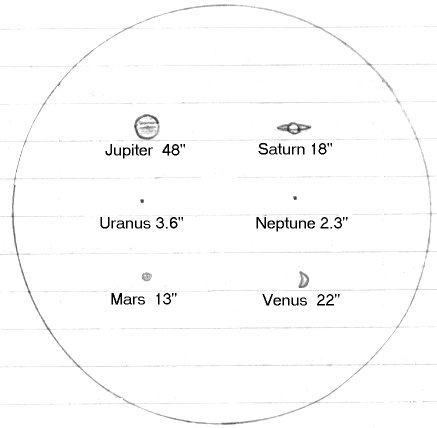 |
| Relatives sizes of Planets through F10/8" LX200, 9.7mm eyepiece, x206 |
Back to Top
2007 (Naked Eye, Binoculars and Camera)
| Mercury at Dusk (Mag -0.7) |
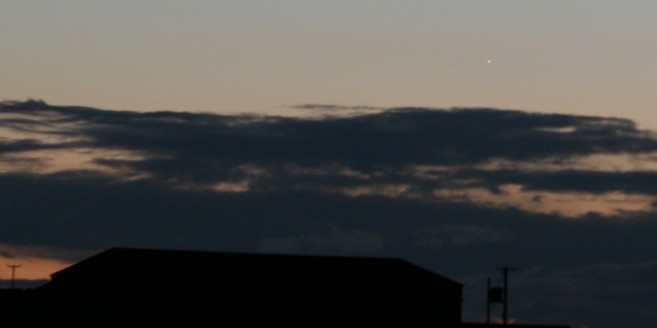
|
| Digital Photo (EOS 400D) 1/3s, f/4, ISO 400, 70mm (cropped) 2007-05-18 21:47 h UT (#IMG_0470) |
2002 (Visual)
I made my first positive sighting of Mercury in May 2002 during the
relatively famous planetary alignment that occurred of that year, when Mercury,
Venus, Mars, Jupiter and Saturn were all visible together in the western evening
sky. There was a lot of public interest in the event and my sighting was during
a public star party at Dave Strange's Observatory Site at Worth Matravers,
Dorset.
1996 (Visual)
Earlier I had a possible sighting of Mercury on 1996-04-01, lying between Venus and the NW
horizon
Back to Top
| Venus (69% phase Mag -4.1) |
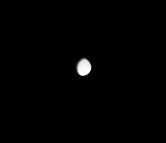
|
| CCD Image, 0.11 sec exposure, lunar filter 2004-02-19 19:27 h UT (#58044) 8" LX200 operating at f/7) |
1996 (Drawing)
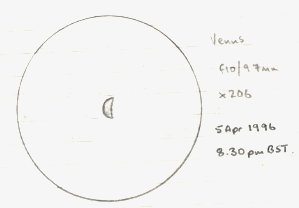 |
| Drawing of Venus, 1996-04-05, 49% Phase (phase however appeared to be less, more like 46% is this related to Schroter effect), |
Back to Top
2003
Recorded images of Mars when close to opposition.
| Mars - close to Opposition (phase 99.6%, 25.0 arc min diameter) |
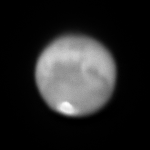
|
| 8" SCT operating at F/29 through eyepiece projection 0.25 sec exposure. Unfiltered. Unsharp masked. Image Scale 0.31 arc sec/pixel (equivalent to surface scale of 85 km/pixel) 2003-08-23 00:32:04 h UT (#52117) |
Recorded my first CCD image of Mars when close to opposition in July/August 2003.
| First CCD Image of Mars |
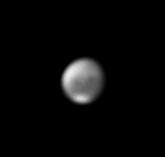
|
| CCD Image 8" LX200 with Barlow 0.12s exposure, unsharped masked 2003-07-13 02:47h UT (#45151) |
1995
Viewed Mars when close to Opposition in January/February 1995. It was the first planet I
looked at through the LX200 and I was initially disappointed that it didn't
appear as a larger disk and didn't show more surface features. My
expectations since have become more reasonable.
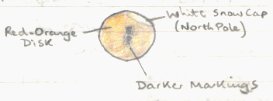 |
| Drawing of Mars, 1995-01-23 Drawn from x206 view |
Following sketches of Mars, showing darker maria markings. The position of markings at roughly the same time of the evening of 1995-Feb-20 and 1995-Feb-22 indicate an approximately 15 deg difference in position of Mars surface. Calculating it out, this is consistent with 24.5 hours day length on Mars, as Mars will rotate 705 deg in the time that Earth rotates 720 deg (i.e. 48 hours).
| Drawings of Mars, 1995 Drawn from x154 view |
||||
 |
 |
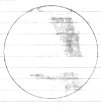 |
||
| 1995-02-20 23:00 UT |
1995-02-205 23:15 UT |
1995-02-22 22:55 UT |
||
First attempt at photo of Mars
Back to Top
2003
| Detailed view of Jupiter ( Io and Ganymede are only just visible in this 0.1 sec exposure) |
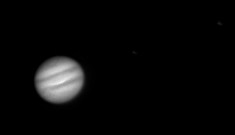
|
| CCD image, 0.1s exposure, Unsharp-Masked 2003-01-24 00:45h UT (#41314) 3.5 x 2.0 arc mins |
2002
| Jupiter | Jupiter revolution over 1 hour |
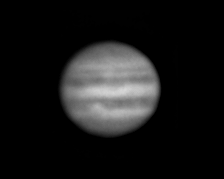
|
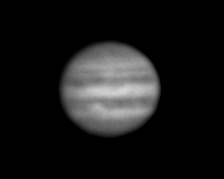
|
| 2002-03-01 23:18hUT CCD Image, 0.3 sec exposure (#18089) Heavy unsharp marking 8"/f10 SCT with Barlow |
2002-03-01 23:14 to 00:07hUT Sequence of CCD Images, 0.3 sec exposure (#18084 et al) Heavy unsharp marking 8"/f10 SCT with Barlow |
| Similar but with light unsharp masking |
2001
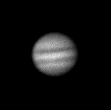
|
| First CCD Image of Jupiter 2001-10-31 (#8081) |
1999
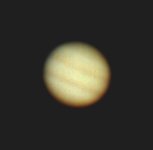 |
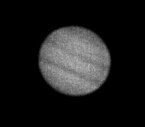 |
|
| Photo, 1999-Dec-07, 00:10 UT LX200, f/10, 9.7mm Eyepiece projection Image enhanced to highlight bands More details |
||
1998
Jupiter is a regular target for my telescope, when its sky position allows.
It is appears as the largest of all the planets through a telescope with an
apparent diameter of around 47 arc seconds (in contrast Mars only gets to a
maximum apparent diameter of around 13 arc seconds).
| Drawings of Jupiter,
1998/99 F10/8" LX200, Drawn from x206 view |
||
 |
 |
 |
| 1998-11-01 23:00 UT |
1999-11-08 22:40 UT |
1999-11-08 22:40 UT |
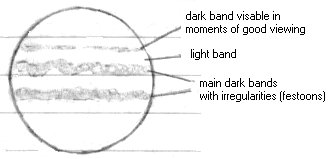 |
| Drawing of Jupiter 1998-Oct-23, 21:45 UT Drawn from x206 view, green filter |
Four of Jupiter's moons are visible orbiting around planet.
Back to Top
Jupiter has lots of moons, but only the the 4 biggest moons are visible through an 8" telescope. They make an interesting subject for telescope observation, as their motion around Jupiter can be followed over the course of a few evenings or even during an evening itself. Jupiter moons can also be readily seen through good binoculars.
2002 (CCD Imaging)
In 2002 I recorded an occultation of Io by Jupiter during a 3.1/2hour CCD
imaging session. (See animated
sequence of CCD Images of Io Occulation 2002-03-07).

|
| 2002-03-07 21:08hUT CCD Image, 1 sec exposure (#19041) 8"/f10 SCT |
2001 (CCD Imaging)
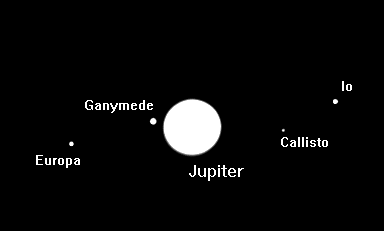
|
| CCD Image, 2001-11-09, 01:17h UT (#10067-71) Jupiter's four main moons appear in this 5 x 0.05 sec exposure |
1999 (Photo Imaging)
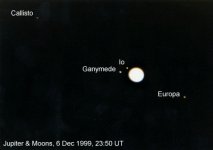 |
| Photo, 1999-Dec-06, 23:50 UT LX200, f/10, 26mm Eyepiece projection, Fujicolor 400, 1 sec exposure |
1998 (Drawings)
| Drawings of Jupiter Moons,
October/November 1998 F10/8" LX200, 26mm, 41deg FOV, x77 view |
|||
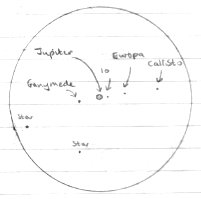 |
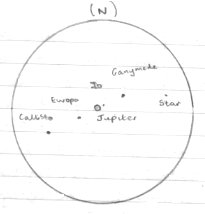 |
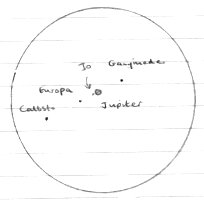 |
|
| 1998-Oct-23 23:00 UT |
1998-Nov-01 18:40 UT |
1998-Nov-01 23:10 UT |
|
Io (a moon of Jupiter) was watched through the course of the evening of 1998-Nov-01 as it transited across the face of Jupiter.
Drawings showing successive stages of the transit (37 kb).
1995 (Drawings)
When one of Jupiter's moons passes between the Jupiter and the Sun, it can
cast a shadow on Jupiter, which can sometimes be observed, see following sketch.
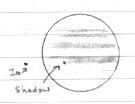 |
| Drawing of Io and its shadow cast on
Jupiter, 1995-Jan-23, 21:40 UT Drawn from x206 view |
Back to Top
|
Saturn |
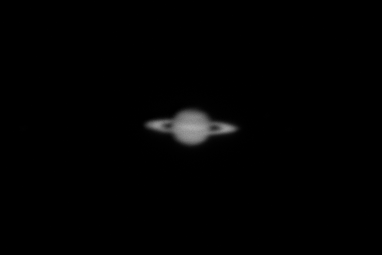 |
| CCD Image (unsharp masked, cropped) 0.12s exposure (single frame), 1x1 binning, C Filter 2011-04-05 23:48 hUT (#466067) 12" LX200R (at f/9.7) + ST-10XME |
|
|
|
Earlier Image of Saturn from Feb 2010 - 2010-02-21 |
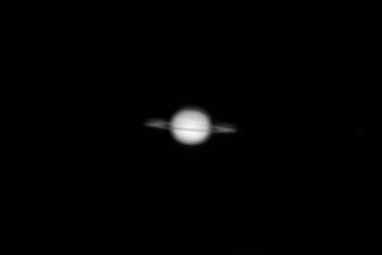 |
| CCD Image (cropped) 0.2 sec exposure (single frame), 1x1 binning, R Filter Unsharp Masked 2010-02-21 00:41 h UT (#414465) 12" LX200R (at f/9.7) + ST-10XME |
2001 (CCD Imaging)
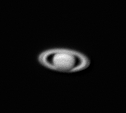
|
| CCD Image of Saturn 2001-Oct-31 (#8043) |
1999 (Photo Imaging)
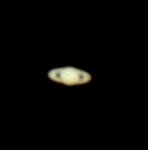 |
| Photo of Saturn 1999-Dec-07, 00:21 UT LX200, 8", 26mm eyepiece projection Cropped and enhanced More details |
1995-1999 (Drawings)
Saturn is famous for its rings. These can be clearly seen in through by
telescope and the changing tilt in the planet can be viewed over successive
years as the following sketches show.
| Drawings of Saturn, 1995-1999 F10/8" LX200, Drawn from x206 view |
|||
 |
 |
 |
 |
| 1995-Oct-20 0 deg tilt |
1996-Nov-10
9 deg tilt |
1998-Nov-01 22:55 UT 16 deg tilt |
1999-Nov-08 23:10 UT 21 deg tilt |
Four to five of Saturn's moons can be seen orbiting around the planet.
Back to Top
|
Saturn Moons |
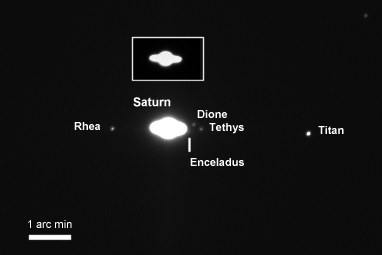 |
| Annotated CCD Image (cropped) 5 x 0.2s exposure (average combine), 3x3 binning, C Filter 2011-04-05 23:46 hUT (#466059-82) 12" LX200R (at f/9.7) + ST-10XME |
|
|
|
Saturn Moons (Titan, Tethys, Enceladus & Rhea) |
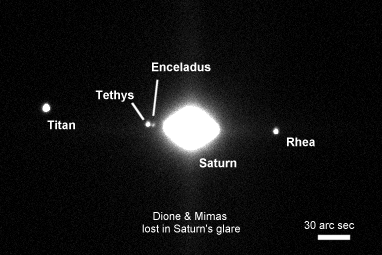 |
| CCD Image (cropped) 0.3 sec exposure (single frame), 2x2 binning, C Filter 2010-02-21 00:44 h UT (#414480) 12" LX200R (at f/9.7) + ST-10XME |
|
|
|
Saturn Moons |
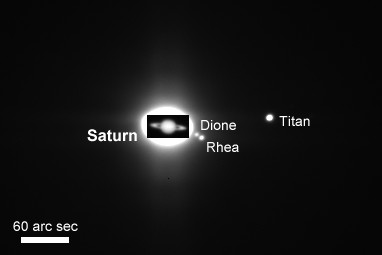 |
| Annotated CCD Image 30s exposure, 1x1 binning (cropped), C Filter (with 0.2s exposure insert) 2008-02-24 21:38 hUT (#268146) |
|
|
2001 (CCD Imaging)
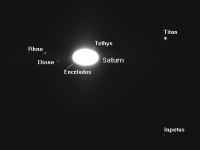
|
| 2001-11-09, 01:03h UT (#10022) Six of Saturn's moons appear in this CCD Image (2 sec exposure) (click on an image for details & larger view) |
1998 (Drawings)
The motion of Saturn's moons can be followed over the course of a few
evenings, just like Jupiter's Moons, as these
following sketches show.
| Drawings of Saturn's Moons,
November 1998 F10/8" LX200, 9.7mm, 15 deg FOV, x206 view |
|
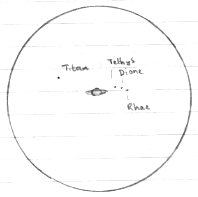 |
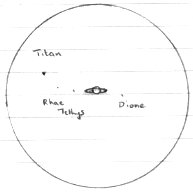 |
| 1998-Nov-01 22:55 UT |
1998-Nov-17 21:50 UT |
Back to Top
2002 (CCD Imaging)
I took my first CCD Image of Neptune on 2002-09-01, and then imaged the plant
on 3 more occasions over the next 20 days. I was able to image the moons Oberon
and Titania and observe their movement around the planet.
| Uranus, Oberon and Titania |
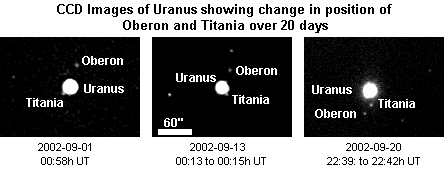
|
| Uranus + the moons Oberon and Titania |
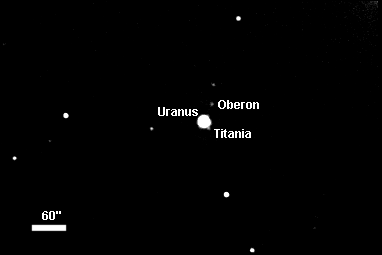
|
| 2002-09-13 00:13 to 00:15h UT CCD Image, 4 x 30 sec exposure (2x2 binning) 11.4 x 7.6 arc min (#25068-72) (Notes on Identification of Uranian Moons) Oberon has a calibrated Magnitude of +14.7 +/- 0.2 |
1998 (Visual)
I viewed Uranus on 1998-Aug-14 , on the same night that I saw Neptune for first
time. The planet had a very small yellowish disk-like appearance.
Back to Top
2002 (CCD Imaging)
I took my first CCD Image of Neptune on 2002-09-23, when I was also able to
image the moon Triton (Mag +13).
| Neptune + the moon Triton |
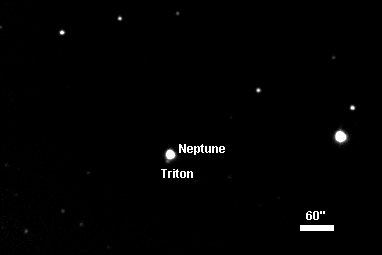
|
| 2002-09-23 21:32 to 21:34h UT CCD Image, 5 x 15 sec exposure (2x2 binning) 11.4 x 7.6 arc min (#27018-22) |
| Neptune + the moon Triton (Neptune mag +7.9, Triton est. mag +13.0) |
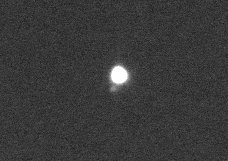
|
| 2002-09-23 21:34 to 21:36h UT CCD Image, 5 x 15 sec exposure (1x1 binning) 3.3 x 2.3 arc min (#27023-27) |
1998 (Visual)
I had my first view of Neptune on 1998-Aug-14, it had a small disk like
appearence, but relatively little else to distinguish it. It lay in the
same part of the sky as Uranus. Finding it would have been difficult without the
GOTO function of the LX200. It was distinctly smaller and dimmer than
Uranus. I viewed Neptune again on 1998-Nov-01.
Back to Top
2003 (CCD Imaging)
An object, believed to be Pluto by comparison with a starfield generated by
TheSky software program, was imaged with CCD in Jul 2003. It's apparent magnitude
(+15.6) was noted to be a lot dimmer than Pluto's catalog magnitude (+13.8). A
later image was collected which provided confirmation that the object imaged was not
a star.
| Pluto (object confirmed by comparison with later clear field image) |
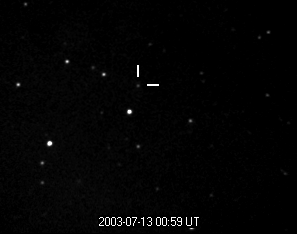
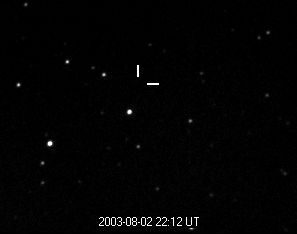
|
| CCD Image taken on 2003-07-13 compared with a later image taken on 2003-08-02 both images 7 x 10 sec (median combine) 8.5 x 7.0 arc min |
A series of CCD images of Pluto were taken over 3 days in August 2003 which clearly show the motion of the planet against the background stars in constellation Ophiuchus.
| Pluto (moving through Ophiuchus) |
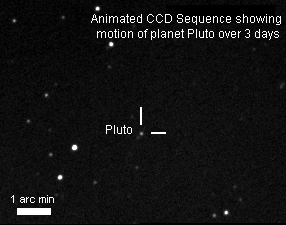
|
| Animated sequence of
CCD images taking over 3 days. Motion recorded as 0.83 arc min per day. 2003-08-02 to 2003-08-05 8.5 x 6.7 arc mins |
2001 (Visual)
I haven't seen Pluto as at 2001. Using TheSky software I located and observed the
precise sky position at which Pluto lay in the constellation Ophiuchus in
2001-Jun. However at Magnitude +13.8 it was just too dim to visually see through
the LX200 with the naked eye, limiting magnitude was judged to lie at around Mag
+12.
I will try Pluto again when visual viewing conditions are better. I will also
try to image Pluto when I get a CCD camera (see 2003 results above)
Back to Top
| This Web Page: | Planets |
| Last Updated : | 2017-12-19 |
| Site Owner : | David Richards |
| Home Page : | David's Astronomy Web Site |